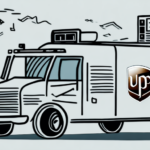How to Request a UPS Shipping Charge Correction for 2nd Day Air Commercial
If you're a business owner or individual who frequently ships packages using UPS's 2nd Day Air Commercial service, it's crucial to be aware of the possibility of shipping charge corrections. These corrections occur when UPS detects discrepancies between the quoted shipping charge and the actual cost of shipping. In this article, we'll delve into the reasons behind shipping charge corrections and provide a comprehensive guide on how to request a correction for your 2nd Day Air Commercial shipment with UPS.
Understanding the Reasons Behind UPS Shipping Charge Corrections
UPS may issue a shipping charge correction for several reasons. Understanding these can help you avoid unexpected charges and ensure accurate billing. The most common reasons include:
- Inaccurate Package Weight or Dimensions: If the actual weight or dimensions of your package differ from what was initially provided, UPS will adjust the shipping charge accordingly.
- Incorrect Zip Codes: Mistakes in the destination zip code can lead to incorrect routing and additional charges.
- Changes in Fuel Surcharges: Fluctuations in fuel prices can affect the overall shipping costs.
- Address Correction Fees: If the shipping address requires correction, UPS may apply additional fees.
- Incorrect Shipping Methods: Selecting a different shipping method than what was used can result in charge adjustments. For example, choosing ground shipping but requesting expedited delivery.
- Residential vs. Commercial Delivery: Shipping to a residential address but marking the package as commercial can incur higher delivery fees.
Understanding these factors is essential for accurate shipping cost calculations. For more detailed information, refer to the UPS Shipping Charges Overview.
Identifying Inaccurate Shipping Charges on Your UPS Commercial Invoice
When you receive a commercial invoice from UPS that includes a shipping charge correction, it's vital to review it meticulously to identify the reason for the correction. Here's how to do it:
- Review Package Details: Check the package weight, dimensions, and destination zip code against your original shipment details.
- Verify Shipping Service: Ensure that the correct shipping service (e.g., 2nd Day Air Commercial) was selected and used.
- Check for Additional Fees: Look for any extra charges such as residential delivery fees or special handling fees that may have been applied.
By carefully examining these elements, you can determine if the correction is valid or if an error has occurred.
Steps to Take Before Requesting a UPS Shipping Charge Correction
Before submitting a correction request, follow these steps to ensure that the charge correction is indeed warranted:
- Double-Check Package Details: Verify the accuracy of the package weight and dimensions entered into your shipping software.
- Confirm Shipping Address: Ensure that the shipping address and zip code are correct.
- Review Shipping Method: Make sure that the selected shipping method aligns with the service used.
If you still believe the shipping charge correction is incorrect after these verifications, proceed to gather supporting documentation.
How to Gather the Necessary Information for Your UPS Shipping Charge Correction Request
Having all the necessary information organized will streamline the correction request process. Ensure you have the following:
- Package Weight and Dimensions: Accurate measurements of your shipment.
- Original Shipping Quote: The initial shipping charge provided by UPS.
- Corrected Charge Amount: The amount reflected in the commercial invoice.
- UPS Account Number: Your unique UPS account identifier.
- Tracking Number: The tracking number for the affected shipment.
- Detailed Explanation: A clear reason why you believe the correction is invalid.
- Supporting Documentation: Copies of the original shipping label, receipts, invoices, and any other relevant documents.
Organizing this information in advance can expedite the review process. Additionally, ensure that you submit your request within UPS's specified timeframe, typically within 15 business days of the invoice date.
Submitting Your UPS Shipping Charge Correction Request Online
The most efficient way to submit a shipping charge correction request is through the UPS online portal. Follow these steps:
- Log In: Access your UPS account on the UPS website.
- Navigate to Shipping Adjustments: Find the section dedicated to shipping adjustments or billing.
- Fill Out the Form: Provide the original shipping amount, the corrected amount, and a detailed explanation for the correction.
- Submit Supporting Documents: Upload any necessary documentation to support your request.
Ensure that you submit your request within the allowed timeframe to avoid being ineligible for corrections. Regularly review your UPS invoices to identify and address any discrepancies promptly.
Contacting UPS Customer Service for Assistance with Your Shipping Charge Correction
If you encounter difficulties while submitting your correction request online, UPS customer service is available to help. Here's how to reach them:
- Phone: Call UPS customer service for immediate assistance.
- Email: Send an email detailing your issue and wait for a response.
- Live Chat: Use the live chat feature on the UPS website for real-time support.
UPS customer service is available 24/7, ensuring that you can get help whenever you need it. Don't hesitate to reach out if you have questions or need guidance through the correction process.
Tracking the Progress of Your UPS Shipping Charge Correction Request
After submitting your correction request, you can monitor its status through the UPS online portal. UPS typically reviews and responds to requests within a few business days. Here's what to expect:
- Approval: If your request is approved, you will receive a credit on your next commercial invoice for the difference between the original charge and the corrected amount.
- Denial: If your request is denied, you can dispute the decision by providing additional information or evidence.
Additionally, the UPS Billing Center offers tools to view and manage your shipping invoices online. This service allows you to track your shipping charges, identify discrepancies, and set up alerts for any changes or updates to your invoices.
Receiving Refunds for Overcharged Shipping Fees on Your Next Invoice
If you've been overcharged due to an error on UPS's part, UPS will issue a refund for the overcharged amount on your next commercial invoice. To ensure you receive any necessary refunds:
- Review Invoices Thoroughly: Check each commercial invoice to confirm that corrections have been applied.
- Contact Customer Service Promptly: If you notice an overcharge, reach out to UPS customer service immediately to expedite the refund process.
- Consider Contract Negotiations: For frequent shippers, negotiating a contract with specific pricing and billing terms can help prevent recurring overcharges.
Maintaining accurate records of all shipping fees and invoices is essential. This practice not only helps in tracking discrepancies but also provides necessary documentation if you need to dispute any charges or seek additional refunds in the future.
Tips for Avoiding Shipping Charge Corrections with UPS in the Future
Preventing future shipping charge corrections involves proactive management and attention to detail. Here are some effective strategies:
- Accurate Package Measurements: Always enter precise weight and dimensions when booking shipments to avoid automatic adjustments.
- Verify Shipping Addresses: Double-check all shipping addresses and zip codes to ensure they are correct.
- Stay Informed on Fees: Keep up-to-date with any changes in fuel surcharges or other fees that may affect your shipping costs.
- Proper Packaging: Use sturdy boxes and appropriate packing materials to prevent damage during transit, reducing the likelihood of additional handling fees.
- Utilize UPS Tools: Take advantage of UPS's online tools, such as address validation and rate quotes, to ensure accurate shipping costs and avoid surprises.
By implementing these practices, you can minimize the chances of encountering shipping charge corrections and ensure that your shipping costs remain predictable and accurate.






















